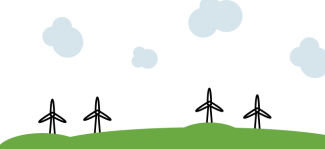From our early days of watching Captain Planet and Saturday morning cartoons, the power of wind was arguably the strongest. Wind is ubiquitous and capable of creating movement. Without wind, there wouldn’t be a whistle. Today, wind energy boosts economic development and contributes to energy security. Wind energy insources over 50,000 active jobs across construction, development, engineering and operations including those in the 550 windmill-manufacturing facilities in the U.S.
To celebrate the rise of wind energy, we are pleased to present three things you may not know about it.
1. Wind energy does not waste other resources while remaining clean and renewable.
Often known as the ‘drought resistant cash crop,’ wind energy reduces environmental impacts by producing zero greenhouse gas emissions. Generating millions of dollars in over 50 countries, wind energy is channeled through windmills that generate power through an ever-present renewable resource without releasing harmful emissions or gases like carbon dioxide. It’s true! A single windmill can power a farm; its electric needs, and even irrigation. Windmills are mostly found on the outskirts of cities, where wind is most prominent, and are present in multiple batches to capture and route energy to the nearest wind turbines. These turbines are stored in wind farms connected with distributive sources that disseminate stored energy accordingly. To top it off, the cost of producing wind power is declining, making the energy sector extremely competitive with zero fuel costs and funding economies around the world. Although it is extremely challenging to build a windmill in the middle of a city, the growing needs of major metropolitan areas may change that.
2. In 2012, wind energy companies invested $25 billion into new wind energy projects in the U.S.
In 2012, wind energy produced 3.5 percent of our electricity, enough to power 15 million homes, creating 80,000 full-time jobs. The $25 billion privately invested in wind farms across the country used the wind production tax credit (PTC) policy. Such policies incentivize wind investments locally and could increase our wind energy production by up to 20 percent in the next 15 years. The world map below shows the advancement of wind energy in the last few decades:
3. Wind energy benefits any organization evaluating its own environmental performance.
As wind uses no source energy or water and produces no emissions during production, it is continually redefining metrics used to evaluate environmental performance. USGBC has its own energy innovations underway. With the recent acquisition of the PEER rating system, which provides a more comprehensive approach to evaluating environmental performance for power use, alternative power is being viewed in a new light as it relates to global sustainability.
Before PEER, renewable portfolio standard (RPS) and percentage of carbon were the two primary performance metrics. PEER incorporates four additional key metrics (source energy efficiency, SO2, NOx, solid waste, and water) in a simple rating system that produces an overall environmental score. PEER reveals that wind is one of the most cost-effective means for improving all aspects of sustainable power. This is also consistent with the new EPA power plant rules, which include source energy efficiency. You can learn more about PEER here
While an industrial windmill cannot be built in your backyard, you can always speak up and lobby for policies that support wind research and alternative energy development around the world.
